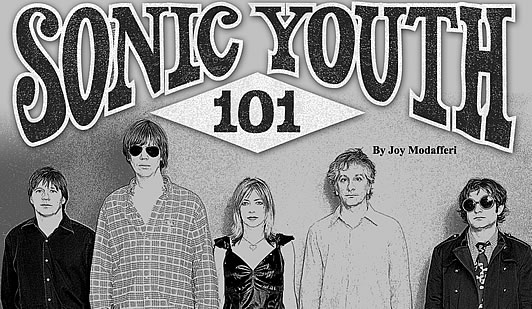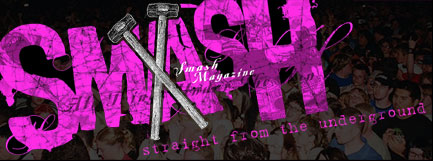Sonic Youth
101
By Joy Modafferi

Like hundreds of bands to hit the
independent American music scene, Sonic Youth has
made their mark. But unlike the majority of those
bands, Sonic Youth is still making music.
In the early 1980’s Sonic
Youth helped form what is now commonly referred to
as “No Wave,” rooting back to artists
such as Glenn Branca and Lydia Lunch. During this
period, New York City was experiencing a musical transformation
spawned by the likes of Iggy and The Stooges, The
Dead Boys, Richard Hell, The Ramones and a slew of
other bands with an entire sound that refused to have
a definitive shape, speed or style.
The visual art world was in full
bloom with figures like Keith Haring and Jean-Michael
Basquiat. The city ranged from Doc Martin wearing
types to the William Blake reading kind of folk. At
the hub of the scene were three musicians- Kim Gordon,
Thurston Moore and Lee Renaldo. Their vision was to
unleash rock music from traditional confines it had
previously known.
In 1985 Sonic Youth interviewed
with Melody Maker Magazine. In an attempt to describe
their vision guitarist Lee Renaldo stated, “We’re
interested in the possibilities for sound-making output
from the guitar, bass and drums in ways that haven’t
been fully explored as we’d like to feel they’ve
been. We’re interested in textural sounds and
the blendings of instruments in ways that don’t
fit into the standard lead and rhythm guitars and
rhythm section backing it up. The music’s got
the emotion, the sentiment and the lyrical thinking
of rock music. We’re a rock band and proud of
it. We’re not an art, noise or extreme band.
We just do what we do.”
Twenty years later they are still
doing what they do. Yet, in that time Lee Renaldo
has undeniably rewritten the vocabulary for the electric
guitar. In a recent interview with Smash Magazine,
Renaldo said he would like to amend that 1985 quote.
“I would definitely put art, noise and extreme
into the equation. There is not anything derogatory
about these terms. A band that has been around as
long we have can rack up a few more adjectives. We
have had a very long career. There have been a lot
of different points to analyze and points that have
contributed to our change and vision.”
Noting different levels of success
with experimentation, Renaldo adds: “We were
achieving our vision from the very beginning. Our
vision is always evolving but I think by the mid-eighties
with our Bad Moon Rising album, we had crystallized
the kind of direction we wanted. We were becoming
more technically proficient, although I don’t
know how much that really helped us out, but it is
something that can’t help but happen if you
play as long as we do. But in some ways we are as
amateurish as we were when we first started.”
It was that amateurish curiosity that inspired, at
least in part, much of the music that made Sonic Youth
famous in the first place.
Sonic Youth has always been known
for experimental guitar playing. It is not uncommon
to see the band toting around more than a dozen guitars
on tour. Each guitar is tuned differently. And some
instruments are juxtaposed together, like a drumstick
jammed under the strings at a specific fret to achieve
a desired sound. There is an obvious separation from
conventional music that was, and is revealed through
their guitar playing.
Renaldo recalls the time when he
first stuck a screwdriver into his guitar: “At
the earliest incarnation of Sonic Youth when it was
basically me, Thurston and Kim, when we were a trio,
before we even had a drummer, we were just figuring
out other ways to make sounds out of the instruments
we had. It happened early-on that we were sticking
drumsticks and screwdrivers up to the instruments
and plugging electric drills into the wa-wa petals.
It was an accepted practice, at least in New York,
to be involved in making rock music, but not just
playing "Louie-Louie" in some garage somewhere.
The impetus for the screwdriver really came about
from the whole New York thing going on at the time.
There was this thing called minimalism, and at that
time people were just playing around with what you
can so with the notion of a string stretched across
two points- may it be a guitar, piano or any stringed
instrument. It goes into the physics of what goes
on with a string at certain points, where you get
theses harmonics jumping out- one of them is on the
ninth fret. I used a screwdriver as an additional
bridge, basically as a metallic wand, and when you
stick it under certain frets on the guitar you get
these acoustic phenomena’s happening. It started
with that.”
Sonic Youth has legitimately earned
and retained their status as indie royalty- an indie
archetype of sorts- despite having signed to a major
label.
Originally in 1986, Greg Ginn of Black Flag signed
Sonic Youth on none other than SST Records. Amazingly,
the band’s stature was enhanced, not diminished
by signing to Geffen/DGC Records. In the process they
were able to help and attract countless other bands
including Mudhoney, Dinosaur Jr., and Die Kreuzen.
It was Sonic Youth that was responsible for the introduction
of Nirvana to Geffen, which, along with Sub Pop released
Nevermind - the album that arguably brought indie
rock into the world of mainstream music.
Each band member is involved with
other projects, which Renaldo says contributes to
both their ability to help other bands, as well as
to the longevity of Sonic Youth. As he explains, “Having
different things going on gives us broad bases to
work from. We are all doing other things than music.
We are involved in books, book publishing, record
releasing, cinematic endeavors- it’s all stuff
we want to pursue. The last half decade or so, we
have curtailed our touring schedules to some degree
around our kids’ schedules. We have found that
we have a little more time to pursue other things-
that’s been real cool because we can utilize
our time better. We are not constantly doing Sonic
Youth stuff. Yet, we are in a unique position for
a band of our type- we have a major label and an indie
label. We are able to operate in both spheres and
we are able to get offers to do all this other stuff.
On some level we are all about working as hard as
we can, pursuing a lot of different things. It is
great to have all these opportunities. We want to
utilize our opportunities- give back to the community
by releasing records by other people because all this
has been afforded to us. We want to take advantage
of the good luck!”
In a perfect world, the alpha dog
would lower his paw and pull up the deserving pups
one by one. The indie community is only as strong
as its relationships. The ones forged between real
people with less than rock star attitudes help keep
it alive. There are few bands in the industry that
have embraced this concept like Sonic Youth.
There is a saying that goes: ”An
unaimed arrow never misses its mark.” Sometimes
having no direction to start off with can be liberating.
And sometimes, being a part of nothing is all the
something you need. As Thurston Moore once said, “We
were a part of nothing. We just said 'fuck it' and
got cheap guitars and screwdrivers and turned up the
amps to ten.”
(Thanks to Lee and Sonic Youth
for the interview, and for playing "Eric’s
Trip" off of Daydream Nation at The H.O.B show
in Vegas.)

